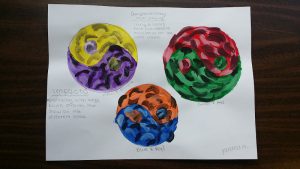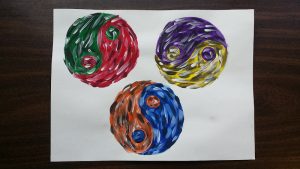Content: Describe what it is you will teach. What is the content?
I will introduce what a complementary color scheme is. Then I will introduce the method of impasto painting by modeling the style on the Elmo. Students will practice painting in the impasto style using complementary colors.
Learning Goal(s): Describe what specifically students will know and be able to do after the experience of this class.
Students will be able to describe what a complementary color scheme is. They will be able to list all the different complementary pairs in the color wheel that include the primary colors. They will also be able to describe how to paint in the impasto style.
Rationale: Explain how the content and learning goal(s) relate to your Curriculum Unit Plan learning goals.
Students will learn that the color wheel is set up such that colors opposite each other act as complements to each other. They will learn that those color pairs are the most contrasting and thus catch one’s eye when used together. They will also be able to practice painting in the impasto style that will prepare them for the final project in this unit.
Assessment: Describe how you and your students will know they have reached your learning goals.
Students must be able to correctly identify and practice painting at least the primary and secondary color pairs. They have exceeded the learning goals if they are also able to pair and paint the tertiary colors together.
Personalization and equity: Describe how you will provide for individual student strengths and needs. How will you and your lesson consider the needs of each student and scaffold learning? How specifically will ELL students and students with learning disabilities gain access and be supported?
The definition of a complementary color scheme will be written on the board so that ELL students can read it at their own pace. I will also visually isolate, by using some sort of straight edge, the complementary pairs on the color wheel to make it easier to identify them. This visual aid will help both ELL and students with learning disabilities understand the content via an input other than auditory. I will model painting in the impasto style, using the same template that I want students to use, on the Elmo projector. Again, the visual prototype will help ELL students and students will learning disabilities understand the content via a visual input.
Activity description and agenda: Describe the activities that will help your students understand the content of your class lesson by creating an agenda with time frames for your class. Be prepared to explain why you think each activity will help students on the path toward understanding.
Day 1: I will introduce the complementary color scheme, define what complementary means and use the color wheel to show the different complementary color pairs. I will also introduce the method of impasto painting by modeling painting in that style. I will project the practice template (that includes drawing yin/yang symbols) step by step, so students can follow along. Students will start to practice painting in the impasto method using complementary colors.
Day 2: Bell Ringer – What is a complementary color scheme? Students will continue painting their complementary color pairs in yin/yang symbols using the impasto style.
What particular challenges, in terms of student learning or implementing planned activity, do you anticipate and how will you address them?
I anticipate that students may not understand, at first, that the entire color wheel can be isolated into pairs of complementary colors. In other words, they may get confused with where exactly opposite colors sit on the color wheel, despite my visual aid. I will repeat using a straight edge to visually isolate the complementary pairs on the color wheel. I can also have students make a simple rectangular viewfinder to place over a color wheel that may help them visually isolate the complementary pairs easier.
List the Massachusetts Learning Standards this lesson addresses.
2.12 Apply knowledge of color theory to a project focusing on the use of complementary colors. Be able to use values of colors in wet and dry media to create the illusion of 3D form on a 2D surface



